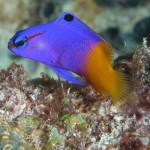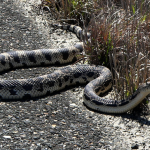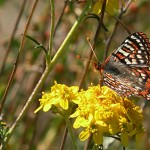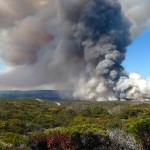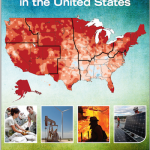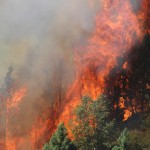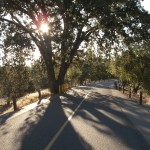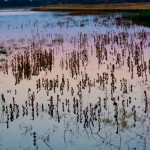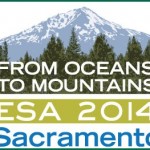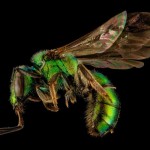- Press top page
- Topic highlights
- Press room information
Lionfish characteristics make them more “terminator” than predator
Thursday, August 14, 2014
Oregon State University
Lionfish appear to stay in one area even as the numbers of prey diminish, and in some cases can eat the population to local extinction. They have unique characteristics that make this possible, and like the terminator, they simply will not stop until the last of their prey is dead.
Thursday, August 14, 2014
Oregon State University
Lionfish appear to stay in one area even as the numbers of prey diminish, and in some cases can eat the population to local extinction. They have unique characteristics that make this possible, and like the terminator, they simply will not stop until the last of their prey is dead.
Roadside research from the pinelands and coast to coast
Tuesday, August 12, 2014
Drexel University
Diane Ward and fellow doctoral students Ryan Rebozo and Kevin P.W. Smith took advantage of a cross-country road-trip from Philadelphia to the meeting in Sacramento this week for some extra ecological data collection.
Tuesday, August 12, 2014
Drexel University
Diane Ward and fellow doctoral students Ryan Rebozo and Kevin P.W. Smith took advantage of a cross-country road-trip from Philadelphia to the meeting in Sacramento this week for some extra ecological data collection.
USGS Science at Ecological Society of America’s Conference: From Climate Change to Fire, Drought, and Wind Energy
Monday, August 11, 2014
US Geological Survey
From climate change to wind energy effects on birds and bats to wildlife disease, U.S. Geological Survey research will be presented at the annual Ecological Society of America (ESA) meetings from Aug. 10 to 14, 2014, in Sacramento.
Complete listing of USGS science at ESA 2014 [pdf]
Monday, August 11, 2014
US Geological Survey
From climate change to wind energy effects on birds and bats to wildlife disease, U.S. Geological Survey research will be presented at the annual Ecological Society of America (ESA) meetings from Aug. 10 to 14, 2014, in Sacramento.
Complete listing of USGS science at ESA 2014 [pdf]
WERC Science at the ESA 2014 Meeting in Sacramento
Sunday, August 10, 2014
USGS Western Ecological Research Center
Ecologist Jill Baron of the USGS Fort Collins Science Center opened the meeting, serving as the current President of the society. WERC scientists will join other USGS colleagues to present talks on topics including wildfire, drought, urban wildlife, Sierra Nevada meadows.
Sunday, August 10, 2014
USGS Western Ecological Research Center
Ecologist Jill Baron of the USGS Fort Collins Science Center opened the meeting, serving as the current President of the society. WERC scientists will join other USGS colleagues to present talks on topics including wildfire, drought, urban wildlife, Sierra Nevada meadows.
Innovations for Endangered Species Recovery
Thursday, August 7, 2014
ESA
40 years after enactment of the Endangered Species Act, shifting public priorities remain an uphill battle.
Thursday, August 7, 2014
ESA
40 years after enactment of the Endangered Species Act, shifting public priorities remain an uphill battle.
History of fire and drought shapes the ecology of California, past and future
Wednesday, August 6, 2014
ESA
USGS ecologist Jon Keeley will synthesize his research on the history of wildfire across the entire state, contrasting historical versus contemporary and forested versus non-forested patterns of wildfire incidence.
Wednesday, August 6, 2014
ESA
USGS ecologist Jon Keeley will synthesize his research on the history of wildfire across the entire state, contrasting historical versus contemporary and forested versus non-forested patterns of wildfire incidence.
Preparing for the effects of a changing climate: Ecologists unwrap the science in the National Climate Assessment
Wednesday, August 5, 2014
ESA
Findings from The Third National Climate Assessment Report (released in spring 2014) will be presented at the Ecological Society of America’s 2014 Annual Meeting in Sacramento, Cal., August 10–15.
Wednesday, August 5, 2014
ESA
Findings from The Third National Climate Assessment Report (released in spring 2014) will be presented at the Ecological Society of America’s 2014 Annual Meeting in Sacramento, Cal., August 10–15.
Climate Change, Predators, And The Trickle Down Effects On Ecosystems
Monday, August 4, 2014
ESA
Ecologists Are Just Beginning To Understand How The Impacts Of Climate Change Are Affecting Predatory Keystone Species And Their Ecosystems. Ecologists Will Report On This And Other Climate-Ecosystem Research News At The Ecological Society Of America’s 2014 Annual Meeting In Sacramento, Cal., August 10–15.
Monday, August 4, 2014
ESA
Ecologists Are Just Beginning To Understand How The Impacts Of Climate Change Are Affecting Predatory Keystone Species And Their Ecosystems. Ecologists Will Report On This And Other Climate-Ecosystem Research News At The Ecological Society Of America’s 2014 Annual Meeting In Sacramento, Cal., August 10–15.
The California Rim Fire one year later: a natural experiment in fire ecology and management
Thursday, July 31, 2014
ESA
Thursday, July 31, 2014
ESA
The 2013 California Rim Fire crossed management boundaries when it burned beyond the Stanislaus National Forest into to Yosemite National Park, providing a natural demonstration of the effects of a history of fire suppression on wildfire dynamics.
2014 Earth Stewardship Initiative Demonstration Project: sustaining and enhancing Earth’s life-support systems
Tuesday, July 29, 2014
ESA
“Cities that Work for People and Ecosystems” is the theme for a full week of demonstration projects in the Sacramento’s American River Parkway during the annual meeting.
Tuesday, July 29, 2014
ESA
“Cities that Work for People and Ecosystems” is the theme for a full week of demonstration projects in the Sacramento’s American River Parkway during the annual meeting.
Stewardship of fire ecology by native Californian cultures
Friday, July 18, 2014
Friday, July 18, 2014
ESA
Before the colonial era, 100,000s of people lived on the land now called California, and many of their cultures manipulated fire to control the availability of plants they used for food, fuel, tools, and ritual. Contemporary tribes continue to use fire to maintain desired habitat and natural resources.
Before the colonial era, 100,000s of people lived on the land now called California, and many of their cultures manipulated fire to control the availability of plants they used for food, fuel, tools, and ritual. Contemporary tribes continue to use fire to maintain desired habitat and natural resources.
California State Senator Darrell Steinberg named as ESA Regional Policy Award winner
Wednesday, July 16, 2014
ESA
ESA’s Regional Policy Award recognizes an elected or appointed local policymaker who has an outstanding record of informing policy decisions with ecological science.
Wednesday, July 16, 2014
ESA
ESA’s Regional Policy Award recognizes an elected or appointed local policymaker who has an outstanding record of informing policy decisions with ecological science.
Ecological Society of America announces 2014 award recipients
Tuesdsay, July 15, 2014
ESA
Ten awards recognizing outstanding contributions to ecology in new discoveries, teaching, sustainability, diversity, and lifelong commitment to the profession to be presented during the Society’s 99th Annual Meeting.
Tuesdsay, July 15, 2014
ESA
Ten awards recognizing outstanding contributions to ecology in new discoveries, teaching, sustainability, diversity, and lifelong commitment to the profession to be presented during the Society’s 99th Annual Meeting.
For bees (and flowers), tongue size matters
Monday, July 14, 2014
ESA
When it comes to bee tongues, length is proportional to the size of the bee, but heritage sets the proportion. Estimating this hard to measure trait helps scientists understand bee species’ resiliency to change.
Monday, July 14, 2014
ESA
When it comes to bee tongues, length is proportional to the size of the bee, but heritage sets the proportion. Estimating this hard to measure trait helps scientists understand bee species’ resiliency to change.
Ecologists converge on Sacramento, Cal. for the Annual Meeting of the Ecological Society of America August 10-15, 2014
Monday, June 16, 2014
ESA
ESA’s 99th Annual Meeting features public sessions bringing research into the realms of policy and planning, touching on California coastal resources, organic farming, disease, and wildlife in urban spaces.
Monday, June 16, 2014
ESA
ESA’s 99th Annual Meeting features public sessions bringing research into the realms of policy and planning, touching on California coastal resources, organic farming, disease, and wildlife in urban spaces.
*
*
